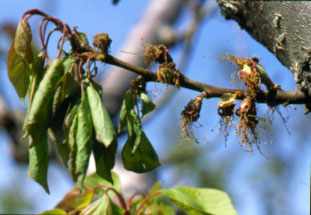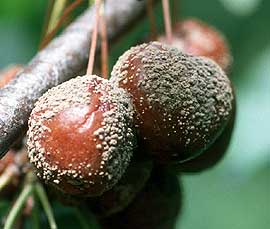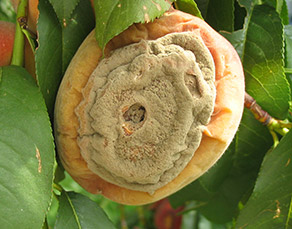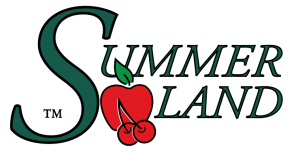Brown Rot (Monilinia fructicola)
General Description
Brown rot is a fungus that may cause serious damage to stone fruits during wet seasons. Prolonged wet weather during bloom may result in extensive blossom infection. Early infections appear as a blossom blight or twig canker. Later infections appear as a rot of ripening fruit on the tree and in storage. Growers marketing cherries overseas should be aware that some markets (e.g. United Kingdom) have a zero tolerance for brown rot.
Symptoms
Blossom Blight: Infected blossoms wilt, shrivel and become covered with greyish mold. Petals may appear light brown or water-soaked, similar to frost injury. Blighted blossoms do not produce fruit. Severe blossom blight is more common on apricot than other stone fruit. The amount of blossom blight directly affects the amount of fruit rot. Dead blossoms may stick to spurs and twigs until harvest, providing a source of spores for the fruit rot phase.
Twig Blight and Canker: On peaches and apricots the infection may spread to twigs, causing brownish, oval cankers that may girdle and kill twigs. Gumming may also occur on infected twigs (Fig. 1).
 |
| Figure 1. Brown rot shoot blight on apricot. (BCMA) |
Fruit Rot: Fruit rot first appears as small, circular brown spots that increase rapidly in size causing the entire fruit to rot. Greyish spores appear in tufts on rotted areas. Infected fruit eventually turn into shriveled, black mummies that may drop or remain attached to the tree through the winter. Brown rot can be serious on injured fruit such as cherries split by rain (Figs. 2, 3).
 |
 |
| Figure 2. Brown rot on cherry. (BCMA) | Figure 3. Brown rot of peach. (BCMA) |
Young green fruit can be infected, but the infection often remains inactive with no symptoms until near maturity. Brown rot can spread after harvest. Mature fruit can decay in only 2 days under warm conditions.
Note: Botrytis rot is also common, particularly on cherries, and symptoms appear similar to brown rot. Correct diagnosis of the rot present is an important consideration when selecting fungicides.
Life Cycle
Overwintering: The fungus overwinters in mummified fruit on the ground or in the tree, and in twig cankers.
Spring infection: Two types of spores are produced in spring which can infect blossoms. Conidia are produced on cankers and fruit mummies in the tree. Apothecia (small mushroom like structures) form on mummies lying on the ground and produce ascospores during the bloom period. Fruit mummies hanging in the tree are the most important source of inoculum in the B.C. Interior.
Secondary Infection: Spores produced on blighted blossoms provide a source of infection for ripening fruit. Rotting fruit on the tree near harvest also provides an abundant source of spores for further infections.
Conditions for infection: Brown rot is more of a problem during wet seasons. Prolonged wet weather during bloom may result in extensive blossom infection. The length of wet periods required for blossom infection depends upon the temperature. The chart below illustrates the length of wet period required for blossom infection to occur at various temperatures.
|
Temperature |
Hours of Wet Required for Blossom Infection |
|---|---|
| 26 ºC | 2 |
| 21 ºC | 3 |
| 16 ºC | 4 |
| 7 ºC | 6-7 |
| 4 ºC | 11-12 |
Ripe fruit can also be infected with only a few hours of moisture. Immature fruit is much more resistant to infection than ripe fruit, but it can also be infected during extended rainy periods.
Management
Cultural Control
1. Orchard sanitation: Remove and destroy fruit mummies when pruning. Prune out any cankered or dead twigs as they are found. Removing rotten fruit from the tree will reduce initial inoculum, which will improve the effectiveness of fungicide sprays. Fungicidal control may not be as good as desired when disease pressure is very high.
2. Pruning: Some cherry varieties such as Lapins tend to produce large clusters of fruit. Brown rot may develop in these clusters more easily due to difficulty of obtaining good fungicide coverage and slower drying of fruit in the middle of the clusters. When pruning remove excessive branches to allow for increased air flow and shorten current season’s growth to reduce fruit cluster formation.
3. Avoid injuring or bruising fruit at harvest. Pick only sound fruit. Discard fruit with brown spots or rot. Dispose of culls and rotted fruit promptly by burying. Precool and keep fruit in cold storage until it reaches destination.
Chemical Control
1. Blossom - Orchards with a history of brown rot require one or more sprays to protect blossoms. Spray when first blossoms open. If wet weather occurs repeat spray at 50 per cent bloom and at full bloom. Select blossom sprays from the following lists of fungicides:
(a) Cherries: Fontelis (penthiopyrad), Sercadis (fluxapyroxad), Luna Sensation (fluopyram + trifloxystrobin), Miravis (pydiflumetofen + difenoconazole), Pristine (pyraclostrobin + boscalid), Rovral (iprodione), Indar (fenbuconazole), Topas or Jade or Tilt (propiconazole), Elevate (fenhexamid), Cantus (boscalid), Captan or Maestro (captan), Nova (myclobutanil), Bravo (chlorothalonil), Senator (thiophanate-methyl), Cueva (copper octanoate), Fracture (BLAD polypeptide - suppression only), Serenade Opti (Bacillus subtilis- suppression only), Kenja 400 SC (Isofetamid - suppression only), Quash (metconazole) or Funginex (triforine). Note: Do not apply Bravo after shuck split to avoid fruit injury.
(b) Peaches: Fontelis, Sercadis, Luna Sensation, Miravis (pydiflumetofen + difenoconazole), Pristine, Rovral, Indar, Topas, Mission, Elevate, Cantus, Captan, Bravo, Nova, Senator, Quash, Funginex, Vangard, or a tank mix of Vangard plus Rovral, Nova, Cueva, Serenade (suppression only), Kenja (suppression only), or Fracture (suppression only). Note: Do not apply Bravo after shuck split to avoid fruit injury.
(c) Nectarines: Fontelis, Sercadis, Pristine, Quash, Indar, Topas, Mission, Miravis (pydiflumetofen + difenoconazole), Elevate, Cantus, Captan, Bravo, Nova, Senator, Vangard, Cueva, Serenade (suppression only), Kenja (suppression only) or Fracture (suppression only). Note: Do not apply Bravo after shuck split to avoid fruit injury.
(d) Prunes and plums: Fontelis, Sercadis, Luna Sensation, Miravis (pydiflumetofen + difenoconazole), Pristine, Rovral, Quash, Indar, Topas, Jade, Tilt, Cantus, Captan, Vangard, Senator, Funginex, Cueva, Serenade (suppression only), Kenja (suppression only) or Fracture (suppression only).
(e) Apricots: Fontelis, Sercadis, Pristine, Luna Sensation, Miravis (pydiflumetofen + difenoconazole), Rovral, Quash, Indar, Topas, Jade, Tilt, Cantus, Vangard, Captan, Cueva, Serenade (suppression only), Kenja (suppression only) or Fracture (suppression only).
2. Ripening fruit- Apply one of the following sprays when the fruit changes colour and a second spray just before picking. Additional sprays may be needed with wet weather. Control insects that cause fruit injury.
(a) Cherries: Fontelis (penthiopyrad), Pristine (pyraclostrobin + boscalid), Luna Sensation (fluopyram + trifloxystrobin), Miravis (pydiflumetofen + difenoconazole), Rovral (iprodione), Indar (fenbuconazole), Topas or Mission (propiconazole), Elevate (fenhexamid), Lance (boscalid), Nova (myclobutanil), Captan (Maestro), Senator (thiophanate-methyl) or Quash (metconazole).
(b) Peaches: Fontelis, Luna Sensation,Miravis (pydiflumetofen + difenoconazole), Pristine, Rovral, Quash, Indar, Topas, Jade, Tilt, Elevate, Cantus, Captan, Nova, Senator, Vangard or a tank mix of Vangard plus Rovral or Nova.
(c) Nectarines: Fontelis, Luna Sensation, Miravis (pydiflumetofen + difenoconazole), Pristine, Quash, Indar, Topas, Jade, Tilt, Elevate, Cantus, Captan, Nova, Senator, Vangard or a tank mix of Vangard plus Nova.
(d) Prunes and plums: Fontelis, Luna Sensation, Miravis (pydiflumetofen + difenoconazole), Pristine, Rovral, Quash, Indar, Topas, Jade, Tilt, Cantus, Vangard, Captan or Senator.
(e) Apricots: Fontelis, Luna Sensation, Miravis (pydiflumetofen + difenoconazole), Pristine, Rovral, Quash, Indar, Topas, Jade, Tilt, Cantus, Vangard or Captan.
3. Immature Fruit – In most Okanagan orchards fungicide coverage on the blossom and ripe fruit stages are sufficient for good brown rot control. However orchards with a history of brown rot problems may want to consider fungicide coverage of green fruit, particularly if weather is wet. Fruitlets are most susceptible prior to shuckfall.
4. Mature Fruit – Ripe fruit ready to be picked, especially apricots and peaches, are very susceptible to brown rot infection. A pre-harvest application of a brown rot fungicide immediately before harvest (1-3 days) is needed to provide these fruit with an adequate shelf life. Generally the shelf life is approximately three weeks for treated fruit kept at around 13C. For this application use only fungicides that have a minimum preharvest interval of three or less days.
5. Harvested Fruit – Scholar (fludioxonil) is registered for use in the packinghouse as a post-harvest dip or drench to control post-harvest diseases including brown rot.
Fungicide Resistance Management
Fungal resistance to fungicides is a high risk for many brown rot fungicides. Alternate fungicides with different modes of action, or use registered tank mixes to reduce the risk of resistance developing in your orchard.
Refer to the table: Chemical Classification & Pesticide Resistance Management for information on fungicide resistance groups and the risk of resistance for different products.
Updated November, 2018
